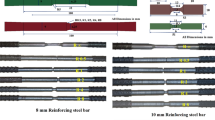Abstract
The advanced high-strength steels (AHSS) have become an interesting alternative to the automotive industry to reduce vehicle weight and therefore reduce fuel consumption. However, the wide variety of applications in the automotive industry is still limited due to challenges in its formability and unloaded behavior of these steels popularly called as springback. Computational tools for numerical simulation have been employed in the industrial environment to help predict the occurrence of springback and defining the appropriate parameters to eliminate or reduce their magnitude. However, the accuracy of the numerical results for AHSS still failed to reach a satisfactory level. The limitation in predicting the springback of AHSS by means of finite element method (FEM) is assigned to computationally difficult to characterize the mechanical behavior of these steels during the plastic strain. The variation of elastic modulus during plastic strain is considered as a major cause of non-linearity of the behavior of these steels. This work aims to study the declining behavior of the modulus of elasticity with an increasing plastic strain objecting to an improvement in the computational prediction of the springback phenomenon of AHSS. Specimens of various AHSS steels were loaded and unloaded in uniaxial tension in 0°, 45°, and 90° to the rolling direction. For all AHSS, it was found that the elastic modulus decreases during loading and unloading after each acquired plastic strain approximately up to 10% of plastic strain and then saturates at higher strain values. Further, the L-bending test was simulated where the change of elastic modulus with respect to plastic strain as observed in the uniaxial tension test is informed through the user subroutine VUSDFLD material model. The springback results were then compared with the experiments. It was found that predictions are in close agreement with experiments after informing the model with the decline of elastic modulus with respect to plastic strain through user subroutine material model as compared to the baseline model.






Similar content being viewed by others
References
Lajarin SF, Nikhare CP, Marcondes PVP (2018) Dependence of plastic strain and microstructure on elastic modulus reduction in advanced high-strength steels. J Braz Soc Mech Sci Eng 40:87
Placidi F et al (2008) An efficient approach to springback compensation for ultra high strength steel structural components for the automotive field. In International Conference on New Developments on Metallurgy and Applications of High Strength Steels. Buenos Aires
Morestin F, Boivin M (1996) On the necessity of taking into account the variation in the Young modulus with plastic strain in elastic-plastic software. Nucl Eng Des 162(1):107–116
Cleveland RM, Ghosh AK (2002) Inelastic effects on springback in metals. Int J Plast 18(5):769–785
Perez R, Benito JA, Prado JM (2005) Study of the inelastic response of TRIP steels after plastic deformation. ISIJ Int 45(12):1925–1933
Lajarin SF, Marcondes PVP (2013) Influence of computational parameters and nonlinear unloading behavior on springback simulation. J Braz Soc Mech Sci Eng 35:123–129
Makinouchi AE, Nakamachi E, Onate, Wagoner RH (1993) editors. NUMISHEET ‘93. The Institute of Physical and Chemical Research
Gau J-T, Kinzel GL (2001) A new model for springback prediction in which the Bauschinger effect is considered. Int J Mech Sci 43(8):1813–1832
Chatti S, Hermi N (2011) The effect of non-linear recovery on springback prediction. Comput Struct 89:1367–1377
Acknowledgments
The authors thank the Usiminas and Arcelor Mittal companies for supplying the steels used in this study and CNPq Agency (Brazil) for a grant.
Author information
Authors and Affiliations
Corresponding author
Additional information
Publisher’s note
Springer Nature remains neutral with regard to jurisdictional claims in published maps and institutional affiliations.
Rights and permissions
About this article
Cite this article
Lajarin, S.F., Filho, R.A.C., Rebeyka, C.J. et al. Numerical study on variation of chord modulus on the springback of high-strength steels. Int J Adv Manuf Technol 106, 4707–4713 (2020). https://doi.org/10.1007/s00170-020-04975-x
Received:
Accepted:
Published:
Issue Date:
DOI: https://doi.org/10.1007/s00170-020-04975-x




